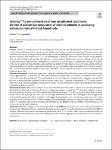Item Infomation
Full metadata record
| DC Field | Value | Language |
|---|---|---|
| dc.contributor.author | Porto, P. | - |
| dc.contributor.author | Callegari, G. | - |
| dc.date.accessioned | 2023-10-03T04:15:12Z | - |
| dc.date.available | 2023-10-03T04:15:12Z | - |
| dc.date.issued | 2023 | - |
| dc.identifier.uri | https://link.springer.com/article/10.1007/s11368-023-03432-y | - |
| dc.identifier.uri | https://dlib.phenikaa-uni.edu.vn/handle/PNK/9419 | - |
| dc.description | Cc-BY | vi |
| dc.description.abstract | Soil loss is considered one of the most important consequences of land degradation as it affects the production of agricultural and forested areas, and the natural equilibrium of aquatic ecosystems downstream. For these reasons, the availability of tools and techniques able to identify areas at risk of land degradation is essential. Over the last 3–4 decades, theoretical models, based on the use of 137Cs, an anthropogenic radiotracer, proved to be very effective for this purpose. However, these models require specific information on soil and sediment particle size to provide estimates of soil erosion or deposition and this information is summarised by a particle size correction factor ‘P’. | vi |
| dc.language.iso | en | vi |
| dc.publisher | Springer | vi |
| dc.subject | sediment yield | vi |
| dc.subject | calculating soil erosion rates | vi |
| dc.title | Relating 137Cs and sediment yield from uncultivated catchments: the role of particle size composition of soil and sediment in calculating soil erosion rates at the catchment scale | vi |
| dc.type | Book | vi |
| Appears in Collections | ||
| OER - Khoa học môi trường | ||
Files in This Item:

